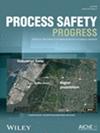天然气站工艺设备中点式和开路式气体探测器的最佳混合布局
IF 1
4区 工程技术
Q4 ENGINEERING, CHEMICAL
引用次数: 0
摘要
由于开路式气体检测仪具有卓越的技术性能,泄漏监测系统往往采用点式和开路式气体检测仪的混合布局。然而,大多数关于泄漏监测优化布局的研究都只集中在点式气体检测仪上。本文从成本效益比和检测时间的角度出发,提出了点式和开路式气体检测仪混合布局的优化模型。由于开路式气体检测仪的测量值是一个积分浓度,因此模拟中的监测线是通过近似矩形法计算得出的。结果表明,使用考虑成本效益比的多目标气体探测器布局和改进的非支配排序遗传算法(NSGA-II)可以优化混合探测器的布局。在一项关于天然气站工艺设施的案例研究中对混合布局进行了分析。随着探测器数量的增加(安全投资),开路气体探测器的比例也随之增加,从而提高了泄漏监测性能和成本效益比。此外,还分析了点式气体探测器的布局。对检测时间的目标函数值进行比较后发现,在我们的研究中,混合布局更具优势。本文章由计算机程序翻译,如有差异,请以英文原文为准。
Optimal hybrid layout of point and open‐path gas detectors in process facilities of natural gas stations
Because open‐path gas detectors offer superior technical performance, leakage monitoring systems tend to use a hybrid layout of point and open‐path gas detectors. However, most research on the optimized layout of leakage monitoring has focused only on point gas detectors. In this paper, an optimization model for a hybrid layout of point and open‐path gas detectors was proposed considering the cost–benefit ratio and detection time. As the measured value of an open‐path gas detector is an integral concentration, a monitor line in the simulation was calculated via the approximate rectangle method. The results showed that the use of a multiobjective gas detector layout considering the cost–benefit ratio and an improved non‐dominated sorting genetic algorithm (NSGA‐II) could optimize the layout of hybrid detectors. The hybrid layout was analyzed in a case study of process facilities at a natural gas station. As the number of detectors increased (safety investment), the proportion of open‐path gas detectors increased, improving both leakage monitoring performance and the cost–benefit ratio. Additionally, the layout of the point gas detectors was analyzed. A comparison of objective function values for detection time showed the superiority of the hybrid layout in our research.
求助全文
通过发布文献求助,成功后即可免费获取论文全文。
去求助
来源期刊

Process Safety Progress
工程技术-工程:化工
CiteScore
2.20
自引率
10.00%
发文量
99
审稿时长
6-12 weeks
期刊介绍:
Process Safety Progress covers process safety for engineering professionals. It addresses such topics as incident investigations/case histories, hazardous chemicals management, hazardous leaks prevention, risk assessment, process hazards evaluation, industrial hygiene, fire and explosion analysis, preventive maintenance, vapor cloud dispersion, and regulatory compliance, training, education, and other areas in process safety and loss prevention, including emerging concerns like plant and/or process security. Papers from the annual Loss Prevention Symposium and other AIChE safety conferences are automatically considered for publication, but unsolicited papers, particularly those addressing process safety issues in emerging technologies and industries are encouraged and evaluated equally.
 求助内容:
求助内容: 应助结果提醒方式:
应助结果提醒方式:


